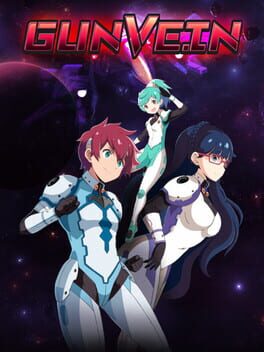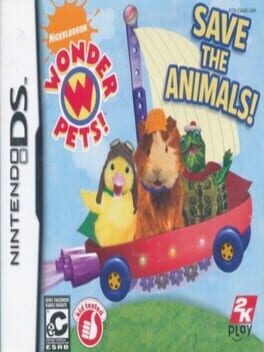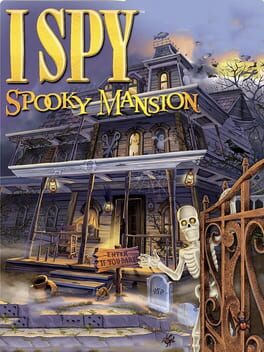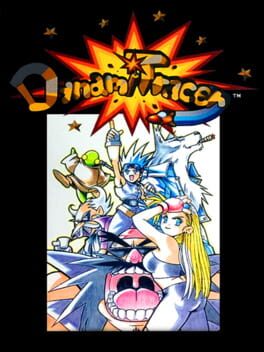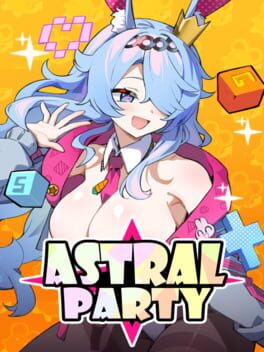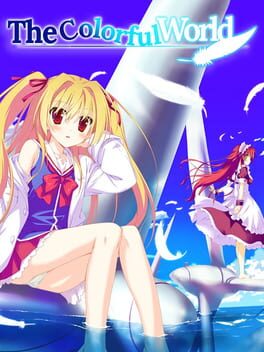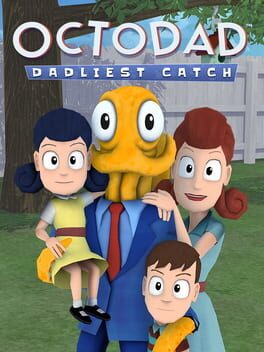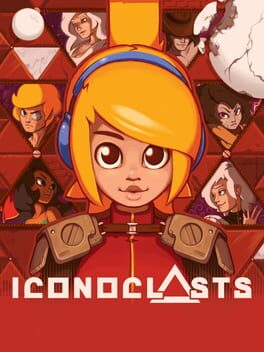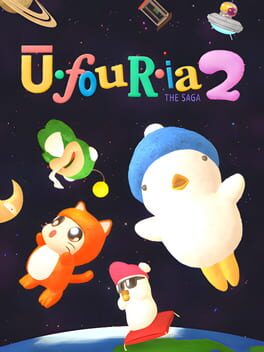raccoons4444
4158 Reviews liked by raccoons4444
Gunvein
2022
Gunvein is a lesson. Even in shmups, arguably the most gameplay driven, distilled form of the videogame there is, you need a bit of flavour. I can safely say Gunvein is a very competent, aggressive shmup. But I can also safely say it's dull and forgettable.
It uses a clever selection of influences as a skeleton for a strong core gameplay loop, decent stage design, and good (if derivative) bosses. The big influences here to me feel like Shinobu Yagawa's games at cave - Ibara, Muchi Muchi Pork and Pink Sweets - with a heavy emphasis on aggressive bombing, score extends and some element of deleberate deaths thanks to a limited life stock. Throw in a scoring system that encourages quick killing absolutely everything you can and it's easy to get into the swing of things the game wants you to.
I would say the gameplay isn't quite there yet though. Difficulty balance is very weak, with the hardest part of the game by far being the stage 3 boss, and stages in general being a bit too easy compared to the bosses. The game's hitboxes are also a bit wonky in that both the ship and bullet's are absolutely tiny - and i do think it should have picked one or the other because you can really just sweep through whole bullet curtains and just scramble dodge without thinking way too much. I get danmaku needs lenient hitboxes but this is a bit too far. Ship balance is also wonky, with the only fun ship - type C - having the good old technical character problem of technically being balanced, but has to really work for it, being more aggressive and effectively multitasking to get the same results Type A and B do with far safer, simpler gameplay - both in scoring and survival.
But it would be easy to overlook the issues if the game had any fucking sauce. Even if I pick some of the most bland shmups out there, lets say; Rolling Gunner, Strikers 1945, Tatsujin - it is absolutely blasted out of the water in terms of thematics, character, story, and just a general feel. Gunvein feels utterly anonymous. The 3 pngs of those characters in the cover there is literally all the character you get. The game doesnt have an ending or any story at all, there's no motivation behind anything, and the aesthetic is this really bland neon-sci fi stuff. It just feels very disconnected from anything. It's just five levels and bosses and the bosses dont even explode with majesty. That aforementioned 3rd boss is positioned as a rival fight (and is also takes a lot from battle garegga's black heart)- a shmup staple where you fight a ship similar to your own, and in a vacuum its a fun fight, but the lack of build up, payoff, pacing and just a reason for it at all makes it feel hollow when this is frankly a really easy trope to turn into something that, for lack of a better term "goes hard."
If the gameplay was absolutely top, top tier it could maybe get away with it. But whilst it's good, all but a few of the cave and raizing games it imitates have better gameplay and every last one of them has better themeing and flavour. Even Deathsmiles 2. In the realm of indie/doujin shmups it fares better but when Rolling Gunner eats your lunch for flavour, aesthetics and thematics, the likes of cambria sword, SF BELUGA, Ikusaaaaaaan, Zeroranger and Blue revolver make Gunvein look particularly souless.
Roguelike arrange is also a huge meme. Its bad and feels pretty desperate to get some more modern gamers on board.
The bright spot of Gunvein is it's tutorial, which legitimately teaches the danmaku concepts of streaming, cut backs and hitboxes very well. It's a shame I can't reccomend this to a new shmuper though, it's so fucking dull.
I wish I could just grab the artists from Drainus and the lead game designer from this and smash them together. Each game has like the opposite half of the games' issues! AAAA.
It uses a clever selection of influences as a skeleton for a strong core gameplay loop, decent stage design, and good (if derivative) bosses. The big influences here to me feel like Shinobu Yagawa's games at cave - Ibara, Muchi Muchi Pork and Pink Sweets - with a heavy emphasis on aggressive bombing, score extends and some element of deleberate deaths thanks to a limited life stock. Throw in a scoring system that encourages quick killing absolutely everything you can and it's easy to get into the swing of things the game wants you to.
I would say the gameplay isn't quite there yet though. Difficulty balance is very weak, with the hardest part of the game by far being the stage 3 boss, and stages in general being a bit too easy compared to the bosses. The game's hitboxes are also a bit wonky in that both the ship and bullet's are absolutely tiny - and i do think it should have picked one or the other because you can really just sweep through whole bullet curtains and just scramble dodge without thinking way too much. I get danmaku needs lenient hitboxes but this is a bit too far. Ship balance is also wonky, with the only fun ship - type C - having the good old technical character problem of technically being balanced, but has to really work for it, being more aggressive and effectively multitasking to get the same results Type A and B do with far safer, simpler gameplay - both in scoring and survival.
But it would be easy to overlook the issues if the game had any fucking sauce. Even if I pick some of the most bland shmups out there, lets say; Rolling Gunner, Strikers 1945, Tatsujin - it is absolutely blasted out of the water in terms of thematics, character, story, and just a general feel. Gunvein feels utterly anonymous. The 3 pngs of those characters in the cover there is literally all the character you get. The game doesnt have an ending or any story at all, there's no motivation behind anything, and the aesthetic is this really bland neon-sci fi stuff. It just feels very disconnected from anything. It's just five levels and bosses and the bosses dont even explode with majesty. That aforementioned 3rd boss is positioned as a rival fight (and is also takes a lot from battle garegga's black heart)- a shmup staple where you fight a ship similar to your own, and in a vacuum its a fun fight, but the lack of build up, payoff, pacing and just a reason for it at all makes it feel hollow when this is frankly a really easy trope to turn into something that, for lack of a better term "goes hard."
If the gameplay was absolutely top, top tier it could maybe get away with it. But whilst it's good, all but a few of the cave and raizing games it imitates have better gameplay and every last one of them has better themeing and flavour. Even Deathsmiles 2. In the realm of indie/doujin shmups it fares better but when Rolling Gunner eats your lunch for flavour, aesthetics and thematics, the likes of cambria sword, SF BELUGA, Ikusaaaaaaan, Zeroranger and Blue revolver make Gunvein look particularly souless.
Roguelike arrange is also a huge meme. Its bad and feels pretty desperate to get some more modern gamers on board.
The bright spot of Gunvein is it's tutorial, which legitimately teaches the danmaku concepts of streaming, cut backs and hitboxes very well. It's a shame I can't reccomend this to a new shmuper though, it's so fucking dull.
I wish I could just grab the artists from Drainus and the lead game designer from this and smash them together. Each game has like the opposite half of the games' issues! AAAA.
Was gonna start with some sort of intro or joke as always but now that I think about it I just wanna quickly say that I adore this game’s box art. The Castlevania series has always been synonymous with banger artwork but the composition and colors in this one are something else, and it’s probably the most menacing Dracula has ever looked in one of these so far… but that shield and sword that Simon is carrying are complete false advertising, that mf isn’t gonna use anything but the whip on this one!
The Adventure is quite a curious entry; as the last game of the series before Akumajou Densetsu, it would be easy to assume that this game was actually the true return of the series of its original roots — unless you count Haunted Castle and its Zelda CD-i looking ass… oh god I’m gonna end up playing that one aren’t I—, but actually, The Adventure feels more like an adaptation of that original adventure into a more simplified platformer, with even the losing power-up system akin to that of the Mario series on top of the usual health-bar and far more simplified and bare level design… oh and also if the original game was kind of a slog.
Christopher is a Belmont, and that means it should have the usual walk full of determination and commitment-based jumps… emphasis on should. The Adventure is s l o w, and when I say slow, I mean s l o w, and it not in a way that feels deliberated. I genuinely thought I was playing as the first protagonist in a game to have arthritis: Chirstopher’s movement doesn’t feel rewarding or like it has heaviness of it, instead it just feels like he’s sliding at a snail pace and like he’s being pushed backwards everytime he jumps, and you know, that’s already pretty bad, but I’m not even taken into consideration the slowdowns ON TOP of that!
I kinda associate this series with framerate problems, it’s always a price that the series has paid in service of its striking vistas and its spectacular boss fights and levels, and I’ve always refrained from mentioning it simply because it was never a problem that really got in the way of my enjoyment of past games and I every time it happened I just thought ‘’yeah, makes sense honestly’’. Here in Game Boy Land however, this old friend has decided to he’s gonna appear more than normal! From the moment the game starts it dawned on me that this wasn’t going to be a very pleasant adventure, and it never really got better, ‘cause even in those moments my jump wasn’t incredibly delayed, and enemies weren’t moving in power-point presentation mode, it didn’t matter because the base movement still sucked!
I believe that single HUMONGOUS problem caused a ripple effect in which other hiccups, some which were already present in previous and even future games of the series, were made even worse: ledge-jumping was a particularly annoying challenge in Simon’s Quest and it would return as the basis of many platforming challenges in IV, but at least in those two you felt in control of Simon, so imagine having to do the same on here but with a less responding character and the punishment being either to have to repeat an entire section or instant-death, at that point I’m sure it would be at least 10 times more fun having to clean Dracula’s own coffin for an hour straight.
The Adventure has interesting sections, mainly the eyeball bridge in Stage 2 and the entire first section of Stage 3, and other moments show snippets of a interesting and possibly fun game, but they are constantly interrupted by incredibly uninspired or frustrating challenges, inconveniences that feel like another level of tomfuckery — even for this series—, and the entirety of Stage 4, which I like to call ‘’The Gauntlet’’, and not in a loving way. If anything, this game has made me gain a much greater appreciation for Super Castlevania IV, ‘cause both games share that same problem, the difference of course being that in here they are much worse. And hey, some complain than in IV there aren’t any new secondary weapons or don’t feel as useful, but hey, in The Adventure there aren’t any to begin with and all your whip upgrades are gone if you are hit even once! JOY.
I’m not entirely sure how much this game being on the system it’s on got in the way of what the game wanted to do, and even if I can still commend the effort of translating a series into the handheld verse, I can’t justify its myriad of problems when nothing about the game itself gives a sense of unbridled creativeness or just general competency. Comparing this to even Simon’s Quest, my least preferred of the original NES trilogy, would be a disservice to the latter, because that game, even if in my opinion failed to bring to fruition most of its ideas, it tried, and in the process created a wonderful and original world and had many sections I do enjoy. In The Adventure, aside from two or three scattered parts in is three first levels, the only thing I got out of it is frustration and a profund sense of boredom.
All Castlevania games made me feel the former at times, but they always were much, much more than that. The Adventure has cool ideas, cool music, some cool visuals, and very little else. I’m sure there could be a good game in here, and maybe eventually there would be, but right now… I would prefer to not see the first boss in my entire life again, thank you very much…
The Adventure is quite a curious entry; as the last game of the series before Akumajou Densetsu, it would be easy to assume that this game was actually the true return of the series of its original roots — unless you count Haunted Castle and its Zelda CD-i looking ass… oh god I’m gonna end up playing that one aren’t I—, but actually, The Adventure feels more like an adaptation of that original adventure into a more simplified platformer, with even the losing power-up system akin to that of the Mario series on top of the usual health-bar and far more simplified and bare level design… oh and also if the original game was kind of a slog.
Christopher is a Belmont, and that means it should have the usual walk full of determination and commitment-based jumps… emphasis on should. The Adventure is s l o w, and when I say slow, I mean s l o w, and it not in a way that feels deliberated. I genuinely thought I was playing as the first protagonist in a game to have arthritis: Chirstopher’s movement doesn’t feel rewarding or like it has heaviness of it, instead it just feels like he’s sliding at a snail pace and like he’s being pushed backwards everytime he jumps, and you know, that’s already pretty bad, but I’m not even taken into consideration the slowdowns ON TOP of that!
I kinda associate this series with framerate problems, it’s always a price that the series has paid in service of its striking vistas and its spectacular boss fights and levels, and I’ve always refrained from mentioning it simply because it was never a problem that really got in the way of my enjoyment of past games and I every time it happened I just thought ‘’yeah, makes sense honestly’’. Here in Game Boy Land however, this old friend has decided to he’s gonna appear more than normal! From the moment the game starts it dawned on me that this wasn’t going to be a very pleasant adventure, and it never really got better, ‘cause even in those moments my jump wasn’t incredibly delayed, and enemies weren’t moving in power-point presentation mode, it didn’t matter because the base movement still sucked!
I believe that single HUMONGOUS problem caused a ripple effect in which other hiccups, some which were already present in previous and even future games of the series, were made even worse: ledge-jumping was a particularly annoying challenge in Simon’s Quest and it would return as the basis of many platforming challenges in IV, but at least in those two you felt in control of Simon, so imagine having to do the same on here but with a less responding character and the punishment being either to have to repeat an entire section or instant-death, at that point I’m sure it would be at least 10 times more fun having to clean Dracula’s own coffin for an hour straight.
The Adventure has interesting sections, mainly the eyeball bridge in Stage 2 and the entire first section of Stage 3, and other moments show snippets of a interesting and possibly fun game, but they are constantly interrupted by incredibly uninspired or frustrating challenges, inconveniences that feel like another level of tomfuckery — even for this series—, and the entirety of Stage 4, which I like to call ‘’The Gauntlet’’, and not in a loving way. If anything, this game has made me gain a much greater appreciation for Super Castlevania IV, ‘cause both games share that same problem, the difference of course being that in here they are much worse. And hey, some complain than in IV there aren’t any new secondary weapons or don’t feel as useful, but hey, in The Adventure there aren’t any to begin with and all your whip upgrades are gone if you are hit even once! JOY.
I’m not entirely sure how much this game being on the system it’s on got in the way of what the game wanted to do, and even if I can still commend the effort of translating a series into the handheld verse, I can’t justify its myriad of problems when nothing about the game itself gives a sense of unbridled creativeness or just general competency. Comparing this to even Simon’s Quest, my least preferred of the original NES trilogy, would be a disservice to the latter, because that game, even if in my opinion failed to bring to fruition most of its ideas, it tried, and in the process created a wonderful and original world and had many sections I do enjoy. In The Adventure, aside from two or three scattered parts in is three first levels, the only thing I got out of it is frustration and a profund sense of boredom.
All Castlevania games made me feel the former at times, but they always were much, much more than that. The Adventure has cool ideas, cool music, some cool visuals, and very little else. I’m sure there could be a good game in here, and maybe eventually there would be, but right now… I would prefer to not see the first boss in my entire life again, thank you very much…
Pulseman
1994
I Spy Spooky Mansion
2009
Super Mario 64
1996
Dynami Tracer
1996
kinda tricky to get running, but worth it. extremely replayable and even more charming. not sure how many creative liberties were taken with the translation, but I thoroughly enjoy the dialoge here. oh, and the character sprites are also on another level, really great stuff. don't want to go into too much detail because the game seems better enjoyed on a blind play-through, but if you enjoy this era of Square games, I highly reccomend checking this out. the game takes under an hour to beat, but becomes more rewarding the more times you play and the better you get at optomizing routes.
Astral Party
2024
Barebones board party game but at least it has content for a free to play game out of the box. I don't mind the free to play aspect since there's not much need to min-max characters.
If they eventually add more/better maps and more spice, it could potentially be something great, but right now it's... a mindless game that at best you should only play a few games in a row before taking a break.
If they eventually add more/better maps and more spice, it could potentially be something great, but right now it's... a mindless game that at best you should only play a few games in a row before taking a break.
I'm sure many people jumping into this review are previous readers of Hoshizora no Memoria (same developer) and want to know how similar Iroseka is. To briefly get it out of the way I would say the two are mostly not the same. There's definitely no Chinami equivalent in Iroseka so you won't be called Onii-chan 10,000 times before you're done with the story. And the drama style, setting, and themes are a lot different.
Pretty Interesting Setting
Despite most of the characters being high school age, which is kind of to be expected of most visual novels, this is NOT a slice of life high school story at all. In fact, I think it would be fair to say that at most the major characters are shown at school like 20% of the time. Iroseka mixes this minor high school aspect with a supernatural setting with parallel worlds. These parallel worlds specifically are a huge part of Iroseka's story as the main character will have many personal reasons for having to travel to or deal with these different areas. I'm not going to get into detail in order to not get into spoilers but I thought the way they integrated the supernatural stuff was quite well done. It helps give Iroseka a unique identity but while still having a huge focus on relatable psychological character drama. I also liked how they slowly built up the powers that Yuuma, the main character, and his ghost girl partner Shinku, are capable of as the story progresses.
Memorable Emotional/Depressing Moments
I am NOT exaggerating when I say depressing. Even as early as towards the end of the common route, you're going to see some stories that delve into pretty heavy subject matter, including but not limited to: lost memories, loneliness, depression, revenge, suicide, terminal diseases, extreme self-sacrifice, physical abuse, trafficking, the dark side of traditions, etc. If any of these sound like potential triggers for you, I would recommend not reading this visual novel. That said, I think the way that Iroseka delves into these subject matter is pretty tasteful. You are not going to see stupidly thrown in edgy H scenes for shock value like some eroge fall into. Quite the opposite. In fact, the visual novel goes heavily into the psychology of each character's mindset as the stuff they have gone through and I think the way that it's both presented and how the characters develop from these situations are quite good and what really got me to quite like a good amount of this visual novel.
Excellent Presentation (Art/Music)
I've always adored the art style of visual novels by developer “favorite” for their bright colors, very distinct character designs, and really good CGs. But I would say the absolute best thing about the presentation in Iroseka is actually the music. The composer Shinobu composes background music for basically every favorite visual novel including Hoshimemo, Iroseka and the currently untranslated Sakura Moyu. But the real stick outs are the emotional songs. As stated earlier, there are some moments in Iroseka that are quite emotional and the excellent background music helps the emotional scenes become even more enjoyable and immersive.
Heavy Use of Flashbacks / Exposition
As stated earlier, this is a visual novel with a pretty big emphasis on the supernatural and parallel world elements, so there's going to be a lot of stuff that needs to be explained. And the writer definitely wants to make sure to describe the many worlds and characters you will meet, including many minor characters’ backstories. To give an example in my favorite girl Kana's route, a good portion of the beginning of her route is giving a whole hour flashback of a side character that is only tangentially related to Kana. This flashback IS incredibly important for the themes of the story, so I definitely did not mind this as well as a lot of the exposition of the supernatural stuff by the dorm daddy, Shigure. They are definitely important to know and I was personally interested in what they had to say. But if you're not a fan of exposition and backstory heavy stories you could maybe think twice before picking up this title. But I thought the author did a good job of not getting too long-winded and a lot of these scenes actually really helped me get into the world and the characters and story even more than I already was.
Inconsistent Route Quality
Iroseka has a commonly used locked true route structure. Meaning you have to read the 4 ‘side’ heroine routes before you unlock the true route. Kana’s is generally considered the best side route and has become one of my personal favorite nakige style routes in isolation. The other side routes are much more hit or miss. Kyou’s has a big plot element that isn’t resolved, Tsukasa’s is way too short despite having an interesting concept, and Mio’s is decent, but just doesn’t hit as hard as I think it should. Basically, I think that the core message and themes of each route are actually pretty good, it's just the amount of care and time given to developing them varies.
As for the true route itself, many people cite it as THE reason to read the visual novel and I can certainly see why. It has very memorable emotional nakige moments and some crazy reveals that happen as early as 15 minutes into the route. However, I have much more mixed feelings about the true route than expected. Similar to the other four routes, I think the core message and themes are actually pretty good, but the issues I have with the true route can be boiled down to 3 things: 1)The plot trying too hard be a supernatural nakige that’s TOO creative 2) A few characters’ actions and stories not making much sense or are just flat out-stupid 3) Some reveals recontextualizing certain aspects of the side routes in a negative way, especially Kana’s where if you noticed I said her route is one my favorites “in insolation”.
Apparently a lot of the flaws I have with the Iroseka get fixed in the currently untranslated sequel, Irotoridoi no Hikari or The Colorful Light. People I’ve talked to cite this sequel as extremely important for filling in a lot of the gaps and details Sekai skipped in order to tell its relatively simpler emotional narrative. So if you are interested and like Iroseka and want to see more, be sure to monetarily support THIS original localization of The Colorful World.
Medicore to Bad Comedy
As I stated earlier, this visual novel has comedy that's very reminiscent of the mid to late 2000s anime harem style comedy. Expect a lot of pervert jokes including but not limited to accidentally walking into a girl changing, girls calling the main guy a pervert when he didn't do anything, or making fun of a supposed fetish that protagonist clearly does not have such as being a lolicon, being into femboys, etc. I've never liked this humor and there are many times where I had to take a break because I was getting really mad whenever these scenes popped up, especially when they happen after pretty important emotional scenes.
That said, the absolute worst offender is the protagonist's mentor “Suzu". The writer just tries to write her off as a “tease" character but The fact that she's a lazy immature person for much of the story is quite annoying. Anytime she makes a mistake, she always tries to dump the blame on the main character Yuuma, or worse try to do things that get him in a situation for the other girls to get unfairly angry at him.
Final Thoughts
Great emotional moments, interesting setting, solid psychological drama, hit or miss route execution and bad comedy.
8/10.
Pretty Interesting Setting
Despite most of the characters being high school age, which is kind of to be expected of most visual novels, this is NOT a slice of life high school story at all. In fact, I think it would be fair to say that at most the major characters are shown at school like 20% of the time. Iroseka mixes this minor high school aspect with a supernatural setting with parallel worlds. These parallel worlds specifically are a huge part of Iroseka's story as the main character will have many personal reasons for having to travel to or deal with these different areas. I'm not going to get into detail in order to not get into spoilers but I thought the way they integrated the supernatural stuff was quite well done. It helps give Iroseka a unique identity but while still having a huge focus on relatable psychological character drama. I also liked how they slowly built up the powers that Yuuma, the main character, and his ghost girl partner Shinku, are capable of as the story progresses.
Memorable Emotional/Depressing Moments
I am NOT exaggerating when I say depressing. Even as early as towards the end of the common route, you're going to see some stories that delve into pretty heavy subject matter, including but not limited to: lost memories, loneliness, depression, revenge, suicide, terminal diseases, extreme self-sacrifice, physical abuse, trafficking, the dark side of traditions, etc. If any of these sound like potential triggers for you, I would recommend not reading this visual novel. That said, I think the way that Iroseka delves into these subject matter is pretty tasteful. You are not going to see stupidly thrown in edgy H scenes for shock value like some eroge fall into. Quite the opposite. In fact, the visual novel goes heavily into the psychology of each character's mindset as the stuff they have gone through and I think the way that it's both presented and how the characters develop from these situations are quite good and what really got me to quite like a good amount of this visual novel.
Excellent Presentation (Art/Music)
I've always adored the art style of visual novels by developer “favorite” for their bright colors, very distinct character designs, and really good CGs. But I would say the absolute best thing about the presentation in Iroseka is actually the music. The composer Shinobu composes background music for basically every favorite visual novel including Hoshimemo, Iroseka and the currently untranslated Sakura Moyu. But the real stick outs are the emotional songs. As stated earlier, there are some moments in Iroseka that are quite emotional and the excellent background music helps the emotional scenes become even more enjoyable and immersive.
Heavy Use of Flashbacks / Exposition
As stated earlier, this is a visual novel with a pretty big emphasis on the supernatural and parallel world elements, so there's going to be a lot of stuff that needs to be explained. And the writer definitely wants to make sure to describe the many worlds and characters you will meet, including many minor characters’ backstories. To give an example in my favorite girl Kana's route, a good portion of the beginning of her route is giving a whole hour flashback of a side character that is only tangentially related to Kana. This flashback IS incredibly important for the themes of the story, so I definitely did not mind this as well as a lot of the exposition of the supernatural stuff by the dorm daddy, Shigure. They are definitely important to know and I was personally interested in what they had to say. But if you're not a fan of exposition and backstory heavy stories you could maybe think twice before picking up this title. But I thought the author did a good job of not getting too long-winded and a lot of these scenes actually really helped me get into the world and the characters and story even more than I already was.
Inconsistent Route Quality
Iroseka has a commonly used locked true route structure. Meaning you have to read the 4 ‘side’ heroine routes before you unlock the true route. Kana’s is generally considered the best side route and has become one of my personal favorite nakige style routes in isolation. The other side routes are much more hit or miss. Kyou’s has a big plot element that isn’t resolved, Tsukasa’s is way too short despite having an interesting concept, and Mio’s is decent, but just doesn’t hit as hard as I think it should. Basically, I think that the core message and themes of each route are actually pretty good, it's just the amount of care and time given to developing them varies.
As for the true route itself, many people cite it as THE reason to read the visual novel and I can certainly see why. It has very memorable emotional nakige moments and some crazy reveals that happen as early as 15 minutes into the route. However, I have much more mixed feelings about the true route than expected. Similar to the other four routes, I think the core message and themes are actually pretty good, but the issues I have with the true route can be boiled down to 3 things: 1)The plot trying too hard be a supernatural nakige that’s TOO creative 2) A few characters’ actions and stories not making much sense or are just flat out-stupid 3) Some reveals recontextualizing certain aspects of the side routes in a negative way, especially Kana’s where if you noticed I said her route is one my favorites “in insolation”.
Apparently a lot of the flaws I have with the Iroseka get fixed in the currently untranslated sequel, Irotoridoi no Hikari or The Colorful Light. People I’ve talked to cite this sequel as extremely important for filling in a lot of the gaps and details Sekai skipped in order to tell its relatively simpler emotional narrative. So if you are interested and like Iroseka and want to see more, be sure to monetarily support THIS original localization of The Colorful World.
Medicore to Bad Comedy
As I stated earlier, this visual novel has comedy that's very reminiscent of the mid to late 2000s anime harem style comedy. Expect a lot of pervert jokes including but not limited to accidentally walking into a girl changing, girls calling the main guy a pervert when he didn't do anything, or making fun of a supposed fetish that protagonist clearly does not have such as being a lolicon, being into femboys, etc. I've never liked this humor and there are many times where I had to take a break because I was getting really mad whenever these scenes popped up, especially when they happen after pretty important emotional scenes.
That said, the absolute worst offender is the protagonist's mentor “Suzu". The writer just tries to write her off as a “tease" character but The fact that she's a lazy immature person for much of the story is quite annoying. Anytime she makes a mistake, she always tries to dump the blame on the main character Yuuma, or worse try to do things that get him in a situation for the other girls to get unfairly angry at him.
Final Thoughts
Great emotional moments, interesting setting, solid psychological drama, hit or miss route execution and bad comedy.
8/10.
Something this singularly focused and confident in what it’s setting out to achieve goes beyond a breath of fresh air and into the realm of interactive mouthwash. Nearly everything about Penny’s game encourages you to stay on the move at all times – it’s present in how the secret areas’ entryways outright throw you in or out, its main enemy type’s mode of attack being chasing you, her bouncy bunny-like outfit and the combo system rewarding you for every trick you pull, and it knows what a joy it is to do so to the point that its main collectibles reward with you with progressively zanier layouts to test your mastery of it in.
It all hinges on building and maintaining momentum, so it’s just as well that her toolkit feeds into both so intuitively. Comparisons to different platformers in this respect are easy – I got enough mileage out of her drop dash equivalent that I occasionally forgot she also has a spin dash one – but viewing this game through the lens of others is selling it short when her yo-yo swing’s the type of thing which makes returning to them initially feel weird for the lack of it. It’s so malleable it’s unreal: an on-demand boost whose strength’s proportional to her speed going into it, contextualised into her design, which can mantle up ledges or grab special items or correct jumps, all dependent on the angle at which you let go and the nearby geometry. Rarely will any two attempts at the same section of a level pan out the same way because of it alone, and that’s without delving into how fluidly almost all of her other manoeuvres interweave with it and what a complementary fit they are for stages so littered with half-pipes and slopes. By no means am I a capital P Penny gamer as of yet, but hopefully this shows what I mean to some degree.
I say “almost” for the same reason as the “nearly” at the start, because although it’s a resounding success at funnelling you into a flow state the vast majority of the time, one or two common interactions stand out as uncharacteristically finicky. The window for maintaining a combo when transitioning from a yo-yo swing into spinning on top of screws feels excessively strict, slightly marring how much I’m predisposed to love any control scheme which even vaguely reminds me of Ape Escape, while obstacles which require Penny to come to a stop (like tree catapults or giant drawers) seem incongruent with how you otherwise pretty much always want to be moving. I’m hesitant to criticise these aspects too much because all manner of unconventional games, not just skill-intensive ones like Penny’s, suffer too often from players’ tendencies to blame them for their own lack of willingness to meet them on their own terms, and knowing that levels can be beat in a single combo makes me think the relative discomfort of these moments is my own fault. Occasional collision issues and/or clipping through terrain are more unambiguously annoying, but in any case, stuff like this is only so conspicuous because everything else about how it plays is so bang on.
That’s similarly true of its levels themselves. While it’s a bit of a pity that the amount of levels per area vary so steeply – Industria and Tideswell, my two favourites in part for the Dynamite-Headdy-if-he-real visuals and being yet further evidence for why Tee Lopes should be made to compose every game ever, only have two levels each – any pacing issues this could’ve potentially resulted in are offset by what a smooth difficulty curve they result in when taken wholistically. The progression from early hazards like water, which can be manipulated to the player’s advantage via the point bonuses it offers by riding on top of it with enough speed, to the absolutely no-touchy electrical discharges powered by breakable lightbulbs in later areas creates this lovely feeling of the game taking its gloves off just as you’ve become acclimatised enough with its systems to no longer need the help. I initially found it frustrating that hazards like the latter hurt Penny if her yo-yo collides with them, but after sitting on it, I can now see that it’s just another example of what a unique platformer this is – substantially extending her hurtbox whenever you perform a trick causes you to really consider when and where to do so in a way that many others don’t really demand of you.
It's evocative of a larger point, which is that Penny’s Big Breakaway is the type of game we could all do with more of. It’s one that’s not afraid to be so out-there in both mechanics and visual design to the point of potentially being offputting for some. It’s one which tangibly takes enough inspiration from the like of Sonic or Mario Odyssey to feel immediately familiar on some level, yet also puts equally as much of its own spin on areas in which it shares common ground with bigger names to the extent that you can’t treat it like them. It’s one that’s in general so unabashedly itself that you can’t not respect it regardless of whether or not it’s to your personal taste, but if you’re at all into the kind of game which gives out as much as you put in and only becomes better as you yourself do, there’s too much on offer here executed to too high of a standard for it not to be.
To extend to it the highest praise in a more succinct way: in art direction, ethos and gameplay philosophy, this is essentially a fully 3D Mega Drive game. Breakaway indeed.
It all hinges on building and maintaining momentum, so it’s just as well that her toolkit feeds into both so intuitively. Comparisons to different platformers in this respect are easy – I got enough mileage out of her drop dash equivalent that I occasionally forgot she also has a spin dash one – but viewing this game through the lens of others is selling it short when her yo-yo swing’s the type of thing which makes returning to them initially feel weird for the lack of it. It’s so malleable it’s unreal: an on-demand boost whose strength’s proportional to her speed going into it, contextualised into her design, which can mantle up ledges or grab special items or correct jumps, all dependent on the angle at which you let go and the nearby geometry. Rarely will any two attempts at the same section of a level pan out the same way because of it alone, and that’s without delving into how fluidly almost all of her other manoeuvres interweave with it and what a complementary fit they are for stages so littered with half-pipes and slopes. By no means am I a capital P Penny gamer as of yet, but hopefully this shows what I mean to some degree.
I say “almost” for the same reason as the “nearly” at the start, because although it’s a resounding success at funnelling you into a flow state the vast majority of the time, one or two common interactions stand out as uncharacteristically finicky. The window for maintaining a combo when transitioning from a yo-yo swing into spinning on top of screws feels excessively strict, slightly marring how much I’m predisposed to love any control scheme which even vaguely reminds me of Ape Escape, while obstacles which require Penny to come to a stop (like tree catapults or giant drawers) seem incongruent with how you otherwise pretty much always want to be moving. I’m hesitant to criticise these aspects too much because all manner of unconventional games, not just skill-intensive ones like Penny’s, suffer too often from players’ tendencies to blame them for their own lack of willingness to meet them on their own terms, and knowing that levels can be beat in a single combo makes me think the relative discomfort of these moments is my own fault. Occasional collision issues and/or clipping through terrain are more unambiguously annoying, but in any case, stuff like this is only so conspicuous because everything else about how it plays is so bang on.
That’s similarly true of its levels themselves. While it’s a bit of a pity that the amount of levels per area vary so steeply – Industria and Tideswell, my two favourites in part for the Dynamite-Headdy-if-he-real visuals and being yet further evidence for why Tee Lopes should be made to compose every game ever, only have two levels each – any pacing issues this could’ve potentially resulted in are offset by what a smooth difficulty curve they result in when taken wholistically. The progression from early hazards like water, which can be manipulated to the player’s advantage via the point bonuses it offers by riding on top of it with enough speed, to the absolutely no-touchy electrical discharges powered by breakable lightbulbs in later areas creates this lovely feeling of the game taking its gloves off just as you’ve become acclimatised enough with its systems to no longer need the help. I initially found it frustrating that hazards like the latter hurt Penny if her yo-yo collides with them, but after sitting on it, I can now see that it’s just another example of what a unique platformer this is – substantially extending her hurtbox whenever you perform a trick causes you to really consider when and where to do so in a way that many others don’t really demand of you.
It's evocative of a larger point, which is that Penny’s Big Breakaway is the type of game we could all do with more of. It’s one that’s not afraid to be so out-there in both mechanics and visual design to the point of potentially being offputting for some. It’s one which tangibly takes enough inspiration from the like of Sonic or Mario Odyssey to feel immediately familiar on some level, yet also puts equally as much of its own spin on areas in which it shares common ground with bigger names to the extent that you can’t treat it like them. It’s one that’s in general so unabashedly itself that you can’t not respect it regardless of whether or not it’s to your personal taste, but if you’re at all into the kind of game which gives out as much as you put in and only becomes better as you yourself do, there’s too much on offer here executed to too high of a standard for it not to be.
To extend to it the highest praise in a more succinct way: in art direction, ethos and gameplay philosophy, this is essentially a fully 3D Mega Drive game. Breakaway indeed.
Iconoclasts
2018
Ufouria: The Saga 2
2024
Ufouria 2 priomises at once to be a remake and a sequel to a cute not well-known Metroidvania from 1991. And... It's neither, actually.
I'm a little confused about what this game is trying to be, but I believe the answer to its strange nature is simple: developers had basically no budget.
Ufouria 2 feels like a sequel to Kirby's Dream Land 3 with incrimental gameplay. You have a hub which leads into multiple levels, some splitting into a few more, and throughout you basically just collect coins and cans. Doing that will stock vending machines allowing you to buy more collectibles and upgrades.
This game is short if you beeline the story and grindy otherwise, asking you to go through the same levels again and again. Granted, levels are somewhat random: taking pre-made chunks and rearranging them, but that doesn't make them feel that different on each time you enter.
What saves this game is its absolutely amazing atmosphere: cute graphics mixed with a lot of 4koma-like dialogue really make this game better than its gameplay would.
It's a cute title, but I wouldn't recommend buying it at asking price. My adventure was over at around 3 hours, and even if I were to grind out the last things I doubt I haven't seen much. Even going through the game normally it falls apart in the last 20% or so by reusing levels and for whatever reason presenting them as new.
It's charming, and I've enjoyed my time with it, but it is a mess.
I'm a little confused about what this game is trying to be, but I believe the answer to its strange nature is simple: developers had basically no budget.
Ufouria 2 feels like a sequel to Kirby's Dream Land 3 with incrimental gameplay. You have a hub which leads into multiple levels, some splitting into a few more, and throughout you basically just collect coins and cans. Doing that will stock vending machines allowing you to buy more collectibles and upgrades.
This game is short if you beeline the story and grindy otherwise, asking you to go through the same levels again and again. Granted, levels are somewhat random: taking pre-made chunks and rearranging them, but that doesn't make them feel that different on each time you enter.
What saves this game is its absolutely amazing atmosphere: cute graphics mixed with a lot of 4koma-like dialogue really make this game better than its gameplay would.
It's a cute title, but I wouldn't recommend buying it at asking price. My adventure was over at around 3 hours, and even if I were to grind out the last things I doubt I haven't seen much. Even going through the game normally it falls apart in the last 20% or so by reusing levels and for whatever reason presenting them as new.
It's charming, and I've enjoyed my time with it, but it is a mess.
Ufouria: The Saga 2
2024
Ufouria: The Saga 2
2024
Ufouria 2 is a genre of game that needs its own name. It's a real hollow nothing bullshit kind of game and I don't mean that derogatorily. The game has such a wonderful cast of characters and a beautifully simple aesthetic and all I want is to have a good time with that core appeal. It's what drew me into playing it in the first place. While mechanically the game is shallow, it is very modern philosophically. The different zones are randomly generated on entry which makes them fresh on revisits, which as a metroidvania, happens frequently. Upgrades are dished out at well calculated intervals. It makes me FEEL like I'm progressing. I don't need to master mechanical complexity in every game I play. Sometimes I just want to enjoy an aesthetic, exist in a world, play a role. But doubly, I dont want to be bored by the game. So while these tricks with the progression and level design may seem cheap (and they admittedly are) they serve the ultimate appeal of the game, which is it's charming aesthetic, and they provide the exact amount of satisfaction and engagement (for my monkey brain at least) necessary to make the short run time fulfilling from beginning to end. The newer Yoshi games could learn a lot from this game.
